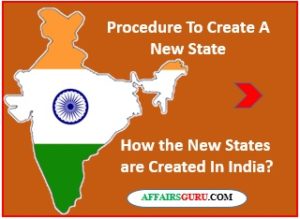How the New States are Created In India? Procedure To Create New State

Procedures of Creating a New State & Provision of Constitutions
Under Article No. 3 of the Indian Constitution, the parliament of India is empowered to create a new state. If you look at India as of today, we have 29 States and 7 Union Territories. By clubbing this all together, this is called India. Today, number is not the same when our constitution came into force (1st Nov. 1956). In 2013 year, there was 28 states in India.
Article 1(1)
Article 1(1) of the Indian Constitution defined that “India, that is Bharat, shall be Union of States“. The word ‘Union’ was deliberately chosen in place of ‘Federation’ to notify that Indian Union is the result of an agreement between states (it can be broken at anyone’s whim) and its components states have no freedom to withdraw from it. That’s why, state’s boundaries can be organised with alternation of boundaries of other states, states can be bifurcated, trifurcated. Central government has always permission to change the name or even boundaries of the states without their permission also. Hence, Dr. B.R. Ambedkar called an “indestructible Union of destructible states” to India.
How is new state formed? OR Creation of New States
In order to create new states, a bill is introduced in parliament but the condition under article 3 is very-2 clear. A bill that is mend for formation of a new state will be introduced in the parliament only on the prior recommendation of president of India. President Permission is a must before introducing the bill. President before giving the permission or recommendation for introducing the bill in the parliament, president has to forward the bill to concerned state legislature that is going to effected with the bill. This bill can also be called state reorganisation bill.
In 2000, 3 new states were created ie. chattishgarh in 1st Nov 2000 and Uttarakhand in 9th Nov 2000 and Jharkhand on 15 Nov 2000. Chhattisgarh was carved out of Madhya Pradesh and Uttarakhand was out of Uttar Pradesh, Jharkhand formed by bifurcating Bihar. By merging two state, a new states can be formed i.e.Andhra Pradesh formed by Madrash (i.e. Andhra State) & Hyderabad in 1956. Constitution can also permit to create a new state by merging two states.
On Jun 2 , 2014, a new states is created called Telangana bifucated from Andhra Pradesh. Everything is mentioned in bill like area.Bill is also called Andhra Pradesh State Reorganisation Act. It is also duty of Central Govt to inform state Legislature as it will effect the state.
A new state can be formed on basis of below three methodologies as follows –
Reorganizing/ Breaking an existing State
Article 3 is allowed the parliament to form a new states and alter the areas, boundaries or name of the existing States by building new laws.
Giving status of mature state to a union territory
A Union territory can be upgraded to a mature state by building suitable law in parliament.
Acquiring a new Territory
Being a sovereign country, India like other country has inherent power to acquire the new territories. It means that whenever a new territory is acquired (i.e. by war, international agreement), there is no need to make a new law. But its formal recognition in Union has been done by building a suitable law as per Article 2.
How do you know number of States and Union Territories in India?
We have 29 states and 7 union territories in India. How do you know? Because it is mentioned in the constitution. But where in the constitution? They are mentioned in the 1st schedule of Constitution. If you open the 1st schedule, you can look at all the name of states & union territories in the alphabetical order. You can also see the area coming under the state.
Whenever any new state created, its name has to be added into 1st schedule of constitution. When you add anything to constitution, that is to call an amendment. This is not an amendment under article 368 of constitution. If you provoke the provisions of article 368,you have to pass this with special majority. Means whenever you create a new state, you have to pass the bill with simple majority, not with special majority under article 360. You are adding new state into 1st schedule of constitution, you are not loosing article 368 but still amending the constitution. Indian Constitution is rigid as well as flexible.UK constitution is most flexible constitution in world i.e. it can be amended with the simple majority. Most of countries have rigid constitution.
In Schedule 4 of constitution, allocation of seats under Rajya Sabha. So 1st schedule nd 4th schedule can be amended with the simple majority i.e. not following the procedure.
Know about Money Bill
Money Bill is also introduced in parliament on the prior recommendation of president.A Money Bill means a Public Bill which in the opinion of the Speaker of the House of Commons contains only provisions dealing with all or any of the following subjects, namely, the imposition, repeal, remission, alteration, or regulation of taxation; the imposition for the payment of debt or other financial purposes.
All the best for your upcoming exam!
You can join or visit at Facebook Page or Twitter for always keep in touch with further updates.
Read more articles….
